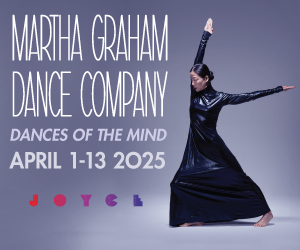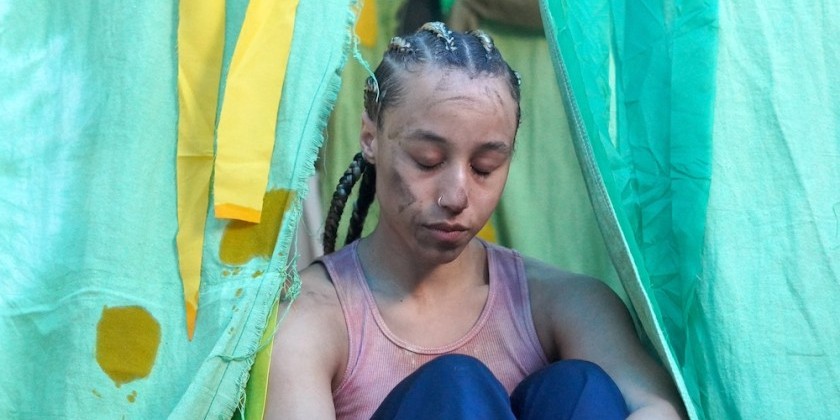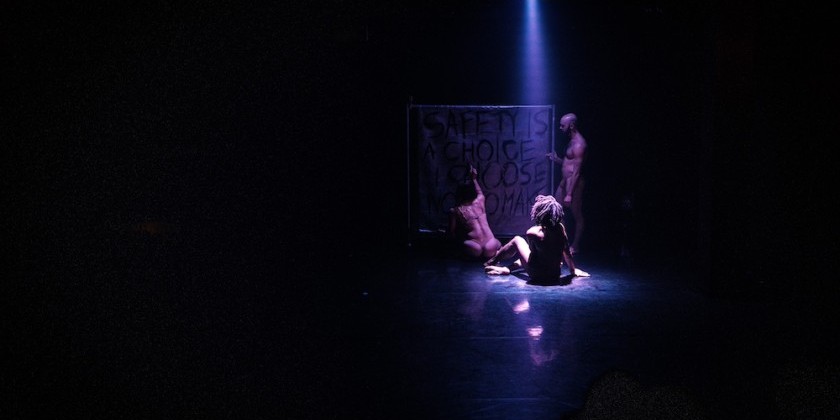IMPRESSIONS: CollabFest at Triskelion Arts Featuring Works by Donna Costello, LMnO3, Annalyn Lehnig

September 20, 2019
Curation: Patrick Ferreri
Lighting Design: David Glista
Artists: Donna Costello, LMnO3, and Annalyn Lehning
The second night of CollabFest, a two-weekend annual showcase of interdisciplinary exchange, now in its eleventh year, was replete with comedic play. But beneath the surface, critical questions of power, agency, and identity simmered. Donna Costello, LMnO3, and Annalyn Lehning, along with their myriad of talented collaborators, presented movement intersecting with costume design, film, theater, and storytelling.
Almost
Choreography and Performance: Donna Costello
Visual Design: Larry Jackson and Jennifer Par
Audio: Jennifer O’Donnell
Almost experiments with the power dynamics of the audience’s gaze. A pre-performance announcement requests that we close and open our eyes to the dancer’s commands of “look” and “don’t look.” Our curiosity and restraint are tested as some inevitably choose to steal glances.
Costello appears wearing an elaborate, gown-like paper apparatus — a precarious construct of feminine beauty, rustling with every move. Cautiously tiptoeing, she stiffly maneuvers her body, trying to keep her garment pristine, but failing. Eventually she gives in to the debacle, disrupting her outfit’s crisp folds with loose torso swings.
At first, Indifferent to the paper that surrounds her, she lets it tear and fall without acknowledgement. Incidental nudity, a product of the disarray, doesn’t seem a concern. Later, angry, she shoves paper off her body, and confrontationally, grabs her crotch demanding that we “look.”
Is she a victim, or an agent — a subject of our gaze, or a commander of it?

unPacking Pina (excerpt)
Choreography and Performance: LMnO3 (Deborah Lohse, Cori Marquis, and Donnell Oakley)
Music and Sound: Léo Delibes, Wayne Newton, Pina Bausch, German Military
The comedic dance collective LMnO3’s unPacking Pina (excerpts) also explores themes of femininity, agency, and gaze while playfully revisiting the career of Pina Bausch. Taken from a longer work, developed through two residencies and several performances, the piece extracts Bausch’s peculiar images of femininity-made-grotesque and blows them up cartoonishly.
In a film directed by Lohse, the dancers parade through picturesque landscapes to a cheeky marching song that names markers from Bausch’s career— from images of virgin sacrifice and dirt onstage in the iconic “Rite of Spring,” to her penchant for semi-nudity and formal-wear, to her ample government funding. Soon, the film’s dancers march onstage, strip out of their sequined dresses to bras and tights, and begin to intimately unravel these Pina tropes.
If Bausch visited archetypes of gender and intimacy with an eye for the uncanny, LMnO3 stretches them further into the realm of absurdity. Limp torsos folded over legs, butts toward the audience, and shifting poses on the floor expose the crotch, rear, and chest in ways that seem more uncomfortable than appealing. Near-nude bodies are exposed rather than presented, sexual images are stripped of “sexiness.”
Dancers are manipulated like dolls, placed in a dress and half-suit, and thrown into an emotionless cycling duet of embraces, butt slaps, and lifts. Later, to operatic music, a performer repeatedly gestures around her breasts with a deadpan seriousness that we can’t take seriously.
Perhaps LMnO3’s affectionate parody is aimed not at Pina herself, but at how quickly her choreographic revolution has fossilized. As dance-theater artists working in a field shaped by this icon, they choose to confront her legacy with equal parts admiration and irreverence.
LAMB/WOLF
Creation and Performance: Annalyn Lehnig
Movement Scores: collaboration with Yvonne Hernandez
Music: The Flamingos, Doris Day, Les Brown and orchestra, Danzig, Giovanni Sollima

In LAMB/WOLF, a one-woman physical theater show, Annalyn Lehnig tells the story of a doomed romance between a wolf cast out of her pack, and a lamb that fled her herd. Costumed plainly in beige dance wear, Lehing relies on her shifting voice, attuned physicality, and extreme facial expression to carry the work.
Howling, prowling, and anxiously scurrying, Lehning physicalizes both characters with a full bodied commitment. She toes the line between earnest and campy, becoming delightfully ridiculous in a slow-motion chase sequence. The extended spoken dialogue becomes repetitive as the two characters gradually challenge their assumptions of each other.
But the piece’s climax is worth the wait. As the lamb offers herself to be eaten by the starving wolf, Lehning alternatively embodies the reluctant predator and their anxiously submissive prey. A glorious complexity of instinctual desire, moral disgust, union, destruction, erotic charge, and sadness are revealed.





![IMPRESSIONS: [RE]DEFINING [SPACE] at Triskelion Arts](/images/features_small/3_Trisk_day_3_selects_by_caroline_alarcon_loor_064.png)






